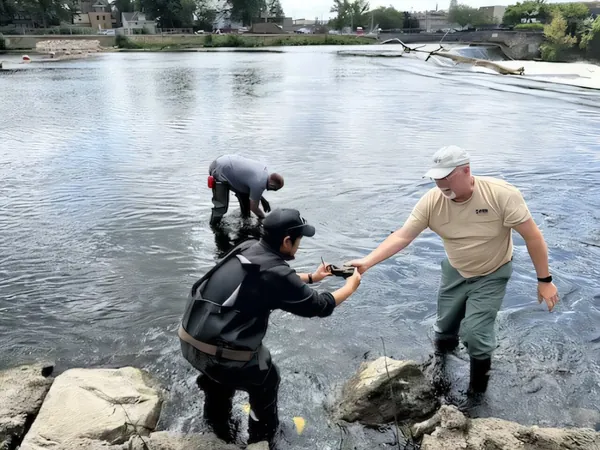
As Great Lakes Heat Up, Fish Face New Threat from Rising Pathogens!
2024-10-24
Author: John Tan
Introduction
In a rapidly changing aquatic environment, Michigan’s rivers and lakes are becoming fertile grounds for dangerous fish pathogens as climate change escalates water temperatures. Researchers from Michigan State University (MSU) are at the forefront of discovering how rising temperatures can impact local fish populations, particularly in light of the newly identified risks posed by the alarming spread of the Tetracapsuloides bryosalmonae parasite.
Research Findings
Bartolomeo Gorgoglione, an MSU assistant professor and lead researcher at the Fish Pathobiology and Immunology Laboratory (FPIL), has uncovered preliminary evidence for the prevalence of T. bryosalmonae across at least three Great Lakes and several rivers in the region. This parasite, classified as an “Emergency Pathogen” by the Great Lakes Fish Health Committee, is notably infamous for causing proliferative kidney disease in salmonid species such as trout and salmon.
Impact on Fish Populations
Although this parasite poses no direct threat to humans, it has devastated both wild and farmed fish populations in Europe and the western United States. Alarmingly, while T. bryosalmonae has not yet been linked to fish deaths in the Great Lakes, increasing water temperatures could rapidly change that scenario. "Warming waters allow the parasite to reproduce quicker," Gorgoglione explained, highlighting an urgent need for further investigation.
Transmission Method
What makes T. bryosalmonae particularly unique—and dangerous—is its transmission method. The parasite cannot spread directly from fish to fish; it relies instead on aquatic invertebrates called bryozoans, colloquially referred to as “moss animals.” These microscopic organisms first become infected and then release spores that can infect fish, especially when water temperatures rise during the summer months.
Field Studies and Findings
Gorgoglione's research has taken a hands-on approach, as his team conducted field studies during this summer, sampling lake trout and exploring local rivers to assess the prevalence of bryozoans and, by extension, T. bryosalmonae. To their surprise, they noted bryozoan colonies proliferating on various debris, including discarded beer bottles, and often shared habitats with invasive zebra and quagga mussels—a finding that raises new questions about ecological interactions and the pathogen’s life cycle.
Potential for Resistance
"From a scientific point of view, it's really exciting," Gorgoglione stated. However, many fish still appear asymptomatic, causing curiosity about the potential for hatchery-bred fish to naturally build resistance to the pathogen—a phenomenon that could change fish management strategies.
Collaborative Efforts
To tackle the impending threat, Gorgoglione is collaborating with the Michigan Department of Natural Resources (DNR) to determine which fish stocks are at risk and identify areas of infestation. He desires to conduct further laboratory studies that could unravel the life cycle of T. bryosalmonae and its implications for salmonid species in the Great Lakes—the first study of its kind in the United States.
Funding and Challenges
The research endeavor faces significant challenges, as Gorgoglione strives to secure grant funding to support an ambitious project aimed at simulating natural conditions conducive to both bryozoans and salmonids in the lab. This critical research could unveil vital data to help safeguard native fish populations against the dual dangers of warming waters and emerging pathogens.
Conclusion
As climate change continues to alter our environment, the struggles of aquatic ecosystems are highlighted, emphasizing the urgent need for research and proactive measures to ensure the health and sustainability of fish populations in Michigan and beyond. Could this be the tipping point for the Great Lakes’ fragile aquatic ecosystems? Only time will tell.

 Brasil (PT)
Brasil (PT)
 Canada (EN)
Canada (EN)
 Chile (ES)
Chile (ES)
 España (ES)
España (ES)
 France (FR)
France (FR)
 Hong Kong (EN)
Hong Kong (EN)
 Italia (IT)
Italia (IT)
 日本 (JA)
日本 (JA)
 Magyarország (HU)
Magyarország (HU)
 Norge (NO)
Norge (NO)
 Polska (PL)
Polska (PL)
 Schweiz (DE)
Schweiz (DE)
 Singapore (EN)
Singapore (EN)
 Sverige (SV)
Sverige (SV)
 Suomi (FI)
Suomi (FI)
 Türkiye (TR)
Türkiye (TR)